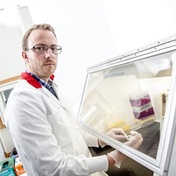Their breakthroughs could make possible the long-sought goal of tailor-made medicine, but without the political, scientific or ethical roadblock of using human embryos.
Both teams call the new cells induced pluripotent stem cells and say they look and act like embryonic stem cells - the master cells that give rise to every cell and tissue in the body."We can now envisage a time when a simple approach can be used to produce stem cells that are able to form any tissue from a small sample taken from any of us," Ian Wilmut of the Scottish Centre for Regenerative Medicine at the University of Edinburgh, said in a statement.
Enormous implications
"This will have enormous implications for research and perhaps one day for therapy," added Wilmut, who helped clone the first mammal, Dolly the sheep, in 1997.
James Thomson of the University of Wisconsin in Madison and colleagues reported their finding in the journal Science while Shinya Yamanaka of Kyoto University in Japan and colleagues reported theirs in the journal Cell.
Both teams used just four genes to transform ordinary skin cells called fibroblasts into induced pluripotent stem cells - iPS cells for short.
"We are now in a position to be able to generate patient- and disease-specific stem cells, without using human eggs or embryos," Yamanaka said in a statement.
Four genes
"These cells should be useful in understanding disease mechanisms, searching for effective and safe drugs, and treating patients with cell therapy," he added.
"By introducing four genes (OCT4, NANOG, SOX2 and LIN28), into human fibroblasts, stem cells sharing essentially all features of human ES cells were obtained," Thomson's team wrote in their report in Science.
"Similar to human embryonic cells, human iPS cells should prove useful for studying the development and function of human tissues, for discovering and testing new drugs, and for transplantation medicine," added Thomson, whose team first discovered human embryonic stem cells in 1998.
Yamanaka's team used a slightly different cocktail of genes - OCT3/4, SOX2, C-MYC, and KLF4 - to get their iPS cells.
Not yet for use in people
Both teams said the new cells are not ready to use in people yet because they used a type of virus called a retrovirus to carry the new genes into the skin cells. It is not clear whether this virus might cause genetic mutations that could cause cancer or other side effects.
"More research is necessary to determine how closely related these cells are to embryonic stem cells, but these methods should be useful for developing disease models and for drug development," Thomson's team wrote.
Yamanaka said the new technology might still raise some red flags for some people.
"Our technology, however, create new ethical concerns. It might be possible to generate sperm and eggs from skin cells, via iPS cells. This might help people with infertility problems, but it will be essential to have proper regulation regarding the generation and usage of human iPS cells to avoid misuse of this technology," he said. – (Reuters Health)
Read more:
Genetics Centre
New source of stem cells
November 2007




 Publications
Publications
 Partners
Partners










